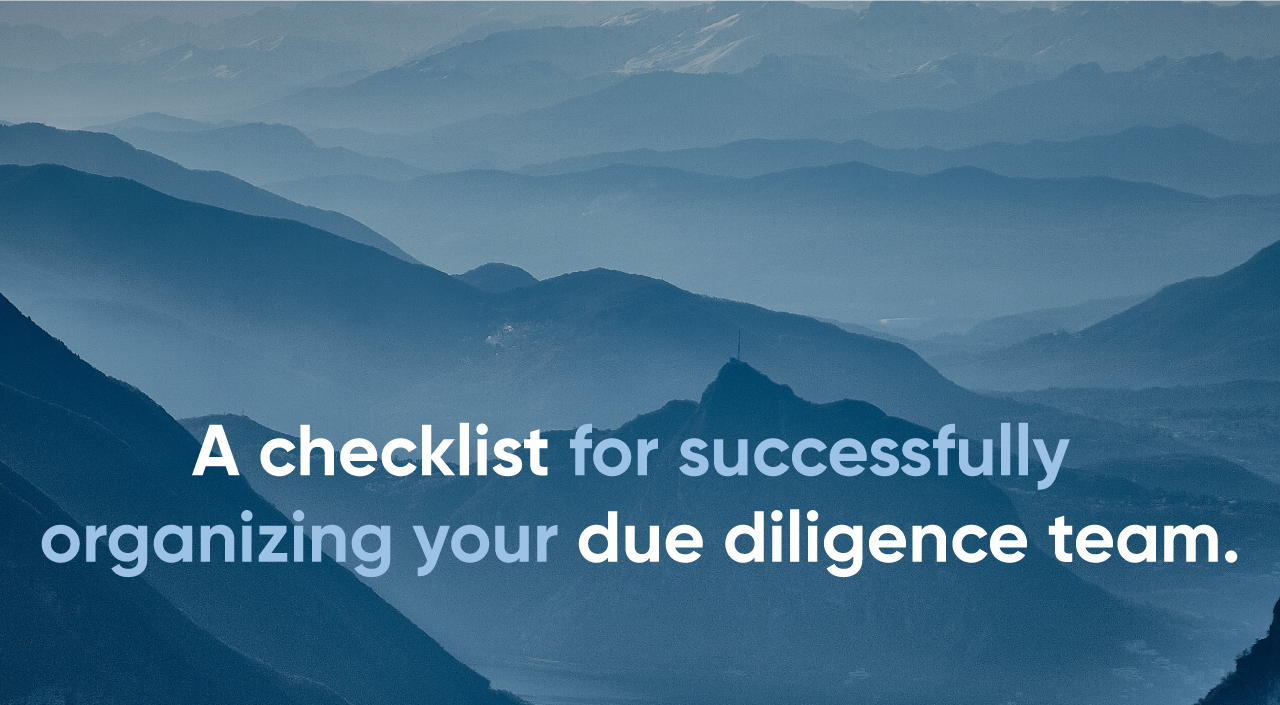
Updated
28.09.2021
5 tips on how to divide roles and tasks in your team.
Don’t know how to divide the tasks within your due diligence team? Does it create a blocker for completing your due diligence processes?
Not having a structured plan available on how to divide the tasks within your team can be a blocker both when you are performing and responding to any type of due diligence (DD) and KYC. It can prevent you from using your resources in an efficient way and can even slow down your business if the initial due diligence process is delayed because of this reason.
It can also cause frustration on the side of your partners and clients if you don’t have a person with the right flexibility and knowledge in place.
So, what should you ask yourself when setting the base for efficient work in your team?
Here are a few questions that you should consider – at the beginning of your DD or KYC process or when you wish to raise efficiency in an already existing process while using an online tool for your compliance work.
1. Do you have enough knowledge about the key activities in your DD tool to write useful descriptions about tasks and responsibilities?
We think that companies should work with the relevant tool for a while before they start adjusting descriptions of routines. Invite all team members and let them use the tool for a few months and improve your instructions as you go along.
If you are starting more or less from scratch, you can start with a simple table of key activities and assign names to each activity.
Add more activities as you start using more features and when you face situations where it’s not clear who’s doing what. Let the instructions grow during a period of time and see it as work in process. Learning about the true capacity of your chosen technology is key if you want to write instructions that really serve as support for your team.
2. Have you placed enough focus on the division of tasks or roles in relation to DD responses?
If you have a policy for DD and KYC, you probably have a section about roles and the division of responsibilities. Usually such policies mainly focus on the performance of DD and maybe that’s why your instructions for DD responses might not represent the same level of detail. This is easy to fix, and it will make a big difference, both in terms of ensuring that you always share correct information with your respective counterparty and that you are not spending too many resources on this.
You will also be seen as a professional partner if your team members can respond to DD and KYC in a structured way.
Clear division of responsibilities and clear description of authorities will help them to do exactly that and may also lead to a lower risk when others are risk assessing your company.
3. Do you have a clear strategy and a responsible guardian for this strategy?
Let’s take DD responses as an example and we like to do that since it is often seen as a big headache. You may have received more than one invitation to a central database for DD and KYC and you probably have a desire to keep the number of company profiles down in order to minimize future work for your team.
You should of course share all information that is necessary according to law, if you think that the relevant counterparty brings you enough business. However, how far should you go in accepting counterparty invitations to different databases and who in your team will make this kind of decision? Also, how far should you go with the production of documents in certain types of DD processes? Is it always worth it from a business perspective? Who should be involved in these types of discussions?
In some cases, you may not have a choice if you want to win a deal and the other party is stronger than you. However, we believe that you do have a choice in more situations than you think, even if you are a small or medium sized player. For instance, if you want to keep the number of company profiles in different databases low, we see a big difference in success when companies have a clear strategy for this and a dedicated person with the right knowledge and experience, who can be flexible in the right cases and push harder for their own cause in other cases.
Your DD response strategy can also stipulate if you should strive for sharing certain types of documents only in certain cases and thereby lowering certain risks.
A strategy can be equally important for your work when you are performing DD and KYC. It can for instance make a significant difference in speed if you clarify to what extent you can allow documents with the same content but in a different form than what you specified in your list of DD requirements. If you go too far in defending your own questionnaires or not allowing partners in other countries to provide the documents which are standard documents in their country, you may create blockers that are not serving the best interests of your company from a business perspective. It can also cause a lot of irritation on the other side and affect your relationship with partners and clients. Hence, it can be a key to pick the right fights but what is the value of such strategy if you don’t have someone who is in charge of it and defends it on a daily basis?
Even though it is essential to clearly describe your strategy, it’s even more important to have someone, who is responsible for executing that strategy.
4. Do you involve your sales team in the right way in your work with DD and KYC?
We see that companies have started to think more about relationship management when they are dealing with DD and KYC. In other words, this means being pragmatic in order to ease the work on both sides and making sure that you are seen as a reliable business partner.
We find that customers who involve the sales team in the right way tend to get motivated partners and clients who are eager to give you what you want. The sales team normally wants to ask less questions than the compliance team, so you need to lay the grounds for a constructive discussion between these teams and make them understand each other. This way, you can avoid asking unnecessary questions, but you can also train the sales team on why you really need to ask certain types of questions. The sales team can also be your way to detect significant changes in the organization or ownership of counterparties.
The sales team is in touch with your partners and clients on a regular basis and it’s an important channel to detect certain types of risks.
Finally, 5 things that may seem obvious but are easily forgotten:
1. Analyzing content is key – not only collecting the right documents.
In some cases, this means that you must know who can make decisions on whether to approve certain documents that meet your base criteria when you cannot strive for the use of your specific form. Because you will end up in these situations, at least if you are aiming at protecting your business while you are securing a compliant process for DD and KYC.
2. Clarify your key criteria to close a DD and KYC process.
We strongly recommend that you are pragmatic. Usually, it is more rewarding for your business to be flexible when it comes to accepting different types of documents that include the requested information but not necessarily included in your unique questionnaire. In order to establish a clear description of responsibilities and assign the right peson to each task, you first need to decide upon the key criteria that must be met in order to complete a DD and KYC process. Your key criteria determine the competence and experience which is needed for this role and thereby, what type of person you should assign to it.
3. Don’t forget to name the persons who should finally approve the DD and KYC reports.
Who should click on the button for final approval of the reports that you make about each counterparty when you are documenting the risk assessment of your counterparties?
That sounds obvious but sometimes it can be blurry and cause a blocker so a large number of reports end up being ready for approval but you do not manage to reach the final step since no one dares clicking on the approve button. Historically, this was often done by a compliance officer or a member of senior management but nowadays we often see that this responsibility is pushed down in the organization, and it can be successfully done if you have clear instructions.
4. Assign more than one person to each task.
Who should do what when you are performing and responding to DD and KYC? Clarify the key tasks that you do in your chosen tool and make sure you have more than one person assigned for each task or that you use a group email for alerts. This way you make sure you can act on time during periods when people are on vacation, and you also minimize the risk of a failed procedure when a key user is leaving your team.
5. Make sure you have at least 2 admin users in your DD tool account.
Who should be an ”admin users” with the highest level of authorization and be able to invite users to your company account and determine their respective level of authorization?
Having more than 1 admin user can be a key if you need to complete a DD process before a certain deadline and you can’t reach the relevant admin user, so you get blocked because you don’t have enough authority and would first need to invite additional users.
The admin users should also have a routine to check the authorities of all users on a regular basis in order to make sure that certain key activities are only performed by specific people.
Have you already started collaborating with your team in a tool for DD or KYC? Or are you still looking for a suitable online solution that lives up to the expectations of all team members?
Find 7 useful tips for how to choose the right DD tool for your DD work here in this article.
Related Articles

Lannebo: Distribution oversight.
A few reasons why Lannebo Fonder chose GRC WATCH for due diligence on distributors but also for due diligence on Lannebo (fund manager). Daniel Sundqvist, Head of Sales and Marketing at Lannebo Fonder.

Joint effort by asset managers in Norway.
Norwegian asset managers wanted to comply with the rules in MiFID II related to "mandatory" due diligence on distributors. They also wanted to minimize the work for the distributors and avoid sending a lot of unique questionnaires to them.
